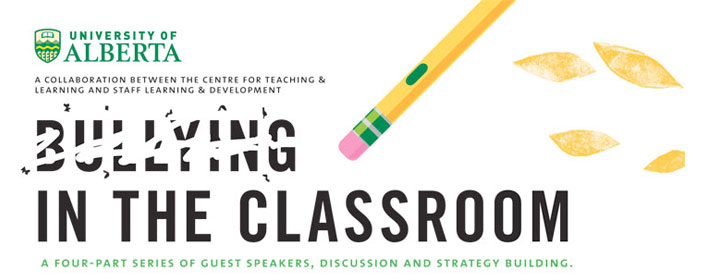Bullying in the Classroom

Date:
January 19, 2012 - 7:30am to April 19, 2012 - 9:15am
Location:
Telus Centre 217/219
Purpose
This four-part series provides instructional staff tools and resources to recognize and appropriately respond to bullying in the classroom and elsewhere on campus.
Desired outcomes
By the end of the series, participants will have:
- A shared understanding of what constitutes bullying
- Understanding of how to prevent bullying in the classroom and online
- Strategies to respond to bullying behaviours appropriately
- Understanding of policies and procedures at UAlberta
- Contacts for on-campus support resources
Series schedule
Third Thursday of the month, starting in January 2012.
Dates
- Thursday, January 19, 2012
- Thursday, February 16, 2012
- Thursday, March 15, 2012
- Thursday, April 19, 2012
Schedule
- 7:00am - Breakfast
- 8:00am - Presentation
- 9:00am - Q&A
Series Topics & Speakers
| Date | Session | Speaker | ||
|---|---|---|---|---|
| January 19, 2012 | What is bullying and how does it manifest in the classroom? We launch the series with a frank discussion to define it and explore the difference between bullying and academic freedom/academic debate; we will come to understand causes, impact and cures. Solutions for individuals are limited; instructors can do more, and educational institutions must want to stop it. We will contrast ineffective personality remedies with systemic solutions that foster genuine cultural conversions to abuse-free, healthy classrooms. |
Dr. Gary Namie, Workplace Bullying Institute |
||
| February, 16, 2012 | Homophobic Bullying: What you should know and what you can do to create safer learning environments. Contemporary research indicates that homophobic bullying is "pervasive, insidious, and starts early" and is a significant factor in school-related violence, perceptions of student safety, and negative mental health outcomes. This session highlights the Alberta Government's groundbreaking resources on homophobic bullying, surveys current research into the health and safety needs of sexual and gender minority (lesbian, gay, bisexual, and transgender, two-spirit, and queer) youth, and provides strategies to help develop a safe, caring, and inclusive campus climate for all students. |
Dr. Kris Wells, Department of Educational Policy Studies, Institute for Sexual Minority Studies and Services, University of Alberta |
||
| March 15, 2012 | Aggressors and Victims in the Shadows of Cyberspace: Exploring the Sources of Online Bullying. This presentation will address a widely discussed issue in the contemporary media environment - cyberbullying, the use of information and communication technologies to intentionally harm others. Amidst the general enthusiasm and optimism surrounding new media adoption and use, cyberbullying stands out as one of the shadowy aspects of cyberspace. Because cyberspace is an emergent and still poorly understood techno-cultural realm, the possible dangers that it breeds are a source of moral panic as well as an object of mystification. In the case of cyberbullying this anxiety is heightened by the fact that this kind of harmful behaviour typically victimizes vulnerable young people. Most research on cyberbullying has followed either a statistical path aimed at capturing the scale and frequency of the phenomenon, or has taken a juridical approach directed at establishing preventive barriers and sanctions against this kind of behaviour. Much more rarely asked are the questions of where cyberbullying comes from, what explains its devastating effects and why the new media environment has proven to be conducive to it. The presentation will focus on these questions by relating the phenomenon to the new and peculiar conditions in which the socialization of young people takes place in a heavily mediatized everyday life. It will offer a perspective on what the implications of cyberbulling, as individual experience and a social phenomenon, might be for the online classroom. Directions for further reflection on ways for designing online learning environments that not only preclude cyberbullying, but also alleviate anxieties related to it among students will be proposed. |
Dr. Maria Bakardjieva, Associate Professor, Faculty of Communication and Culture, University of Calgary | ||
| April 19, 2012 | Delete Bullying This session will enable participants to better understand the dynamics of bullying and develop strategies to address and eliminate bullying behaviours in work and learning environments at post-secondary institutions. Participants can expect an engaging and interactive session featuring group discussions and videos that will provide them with some of the latest information, resources and tools available to assist in preventing and addressing bullying behaviours. The session will highlight activities and resources at the U of A. |
Wade King, Office of Safe Disclosure and Human Rights, University of Alberta |
Additional Information
For more information on bullying, please visit the Office of Safe Disclosure and Human Rights
Bullying-Related Resources & Research
- http://bulliedacademics.blogspot.com/2010/03/workplace-bullying-in-academia-canadian.html
- http://cord.acadiau.ca/tl_files/sites/cord/resources/Documents/Article1Bullying.pdf
- http://www.the-drs-namie.com/links/
- http://www.acosomoral.org/pdf/Westhues.pdf
- http://www.universityaffairs.ca/the-wild-web.aspx
- http://bulliedacademics.blogspot.com/2009/08/workplace-bullying-epidemic-worse-than.html
- http://www.ismss.ualberta.ca/people/kriswells.htm
- http://www.bullyfreealberta.ca/homophobic_bullying.htm
Resources
March 15: Exploring the Sources of Online Bullying (PDF)
April 17: Delete Bullying (PDF)
Accessibility needs
We are committed to making the Series accessible for all interested participants. The Telus Centre is a wheelchair accessible building. In addition, sign language interpreting services, realtime captioning, or other access-related services or accommodations can be arranged. If you have any accessibility needs, please contact Catherine Anley, Employment Equity Advisor at 780.492.3020 or catherine.anley@hrs.ualberta.ca one week prior to each session.